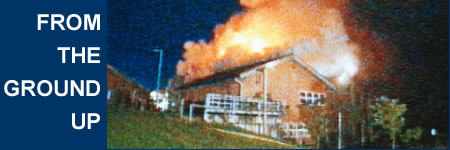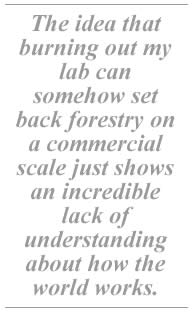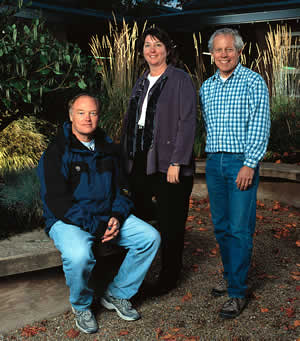
That may soon be a moot point. ELF, which in 1990 burned down a $12 million Colorado ski resort, claimed responsibility for destroying a Forest Service research station in Pennsylvania this summer. And, in a shivery change of attitude that no one at the center has failed to note, the ELF has promised that it "will no longer hesitate to pick up the gun" in future actions.
Bradshaw says he could have predicted this. "Ultimately, the decisions that the ELF are trying to influence are not made at all by people like me. They're made by politicians and voters. The idea that burning out my lab can somehow set back forestry on a commercial scale just shows an incredible lack of understanding about how the world works. They almost never target the 'right' thing, and it never, as far as I know, has the desired effect. That's why I think you see an escalation in the level of violence in their rhetoric."

Hinckley sees a parallel between the ELF and those who bomb abortion clinics. "First you picket, then you bomb, then you start shooting people," he says. He's not particularly frightened for himself. "But I'm concerned about some people who have been identified by this group."
Bradshaw shrugs off concerns for his personal safety. "I'm just not the worrying kind," he says. "There are much bigger things in the world to worry about." Although the University has taken reasonable precautions, Bradshaw says, the cost of absolute security would be too dear. "I would never want to adopt a fortress mentality," he says. "That's just antithetical to how public universities should treat the citizens of their state."
The decision to rebuild the center was made quickly, although working out the details has been an ordeal. The Washington Legislature promptly allocated $4.1 million toward replacing Merrill Hall, but it was soon apparent that that would not be enough. Eventually the University procured an additional $1.3 million, enough to construct a new building of the same size on the old foundation.
In a sense, the new building will be smaller, however, since wider hallways, an elevator, and other factors to bring it up to code will reduce usable space by about 600 square feet.
Rebuilding has presented an opportunity to rethink the design, as well. The new Merrill Hall will showcase sustainable features for demonstration and teaching. All the outreach functions, such as the library, the Master Gardeners clinic and the herbarium, will be clustered together. Private donations and special efforts-such as the sale of personalized leaf-patterned floor tiles-are helping make the new Merrill Hall a place that can better accommodate use by the public. Reconstruction is optimistically slated to begin next spring, with completion by May 2004, the three-year anniversary of the fire. For more about the rebuilding efforts or to make a donation, visit the center's Web site at www.urbanhort.org.

In the courtyard of the Center for Urban Horticulture are (from left) Professors H.D. "Toby" Bradshaw and Sara Reichard, and Center Director Rom Hinckley. Photo by Mary Levin.
On the anniversary of the bombing this spring, the center held a celebration, with speakers and guests, donated food and a generous helping of relief. "There were many times during the last year when I didn't think we had the energy to make it," Reichard says. "But somehow we made it a year. That really was a turning point for me."
In the aftermath, "I expended a fair amount of energy thinking about revenge," recalls Hinckley, but he adds that 9/11 put things in perspective. "I think you begin to realize you've been dealt a setback, but you're still walking, and no one got physically hurt. Time heals wounds." And there have been some positive aspects: the cohesiveness of the group, seeing the University's strength in a crisis, learning that the UW Physical Plant is an amazing force, the improvements in the new building, and the faculty's demonstrated resilience.
"I sometimes wonder where they get the energy and drive to do all the things they do," he says, including keeping up with class loads and providing community outreach programs. "This might have been a good excuse to retire, to quit, to just drop way back in load and energy," Hinckley says. "Instead, everyone dug in and showed that they were going to go through the recovery and keep the programs alive and actually see them prosper, take them to the next level."
It takes a lot more than total destruction to keep plant people down.
Free-lancer Beth Luce lives and gardens in the Seattle area.
Go To: Page 1 | Page 2 | Page 3 | Page 4- Sidebar: Surviving the Flames
- Return to December 2002 Table of Contents